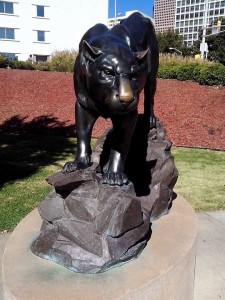Pounce is a life-like, life-size sculpture of a panther cast with a sleek and muscular tone. Pounce is the representation of a beautiful and majestic panther, caught in the act of moving forward. The statue is dark in color, but it appears gray with the light of the sun. Its surface is smooth in the sense that it does not present ripples except on the neck, chest, and paws. In these three areas, there are ripples that indicate the presence of soft fur. For the rest, no other traces of fur are visible. The coat color is plain black without spots. The body measures in length more than four feet, and the long tail measures approximately twenty-five inches. The tail is perceptibly curved and points upwards; the definition of the muscles on both sides is clearly elaborated, as well as the strong lines defining the muscles of the legs; the face is not frontal, but slightly bent to the left. The same detailed precision is reserved for the paws. They are large and powerful, and the fur between the toes is incredibly well-modelled. The hind legs are larger and longer than those at the front. The ears of the statue are bent back in listening mode. The head is small compared to the rest of the body, and the eyes are rather big and deep-set, with the pupil not circular in shape, but drawn by two sharp lines. A tangle of fine lines building the underlying musculature suggests the pronounced jaw as well as the elaborateness of the upper part of the head. The nose is broad, outlined by a thin rectangle. At the rectangle’s base, there is a little oval representing the main part of the nose: the nostrils from which the animal is supposed to breathe. The nose is of a different color than the rest of the statue. While the statue is black or dark gray, the nose is clearly golden. The mouth is shut and characterized by a plain line that crosses the lower part of the face horizontally. The face has no visible whiskers. The base on which the statue stands is a simple rock of the same color as the rest of the statue; however, the base does not present a regular configuration because the outlines of the rock are jagged and irregular. The plaque at the base of the statue reads: “Donated by the Georgia State University Alumni Association on its 75th anniversary; Dedicated February 12, 2005. ‘Promoting Panther Pride.’” The plaque is black and the words are written in white. The logo of the university, a blue stylized paw, appears at the bottom right-hand corner of the plaque.
Pounce is not only a statue, but also the mascot of Georgia State University. This bronze reproduction seems ready to pounce on an enemy, hence the nickname “Pounce.” The smooth fur is a realistic detail as panthers are not animals with a thick fur, like wolves and polar bears for instance; the layer of fur that protects their bodies is rather thin as the one found here. Depicting a panther in the process of moving forward is a possible allusion to the path towards the brilliant future that awaits every student, while the base with its irregular edges may allude to a wild landscape in which Pounce is wandering. This detail suggests the idea that sometimes students need to act “wildly” in their academic career and break the rules to achieve successful results. As previously mentioned, the passers-by can notice that Pounce’s nose is of a bright yellow. Indeed, several generations of students have touched Pounce’s nose before their tests, because this gesture is believed to be a good luck charm. Rubbing Pounce’s nose has now evolved into a solid tradition. Although this convention is quite old now, students keep it alive, as evidenced by the different color of the nose. In the same way, the plaque would seem to promote a sense of devotion and attachment to the school, especially underlined by the last words in which “panther” becomes an attribute for “pride.” Furthermore, the plaque looks like a classroom blackboard and references to the academic institution in general. The fact that the Student Alumni Student Association collected the funds to build the statue is significant as this donation shows the profound dedication, enthusiasm, and pride that the alumni still feel toward their old university, an affection that led them to finance the building of a statue that may become, if it is not already, a relic. The statue finds its home on the main campus in the Unity Plaza, a small square situated in front of the Student Center. It proudly stands as a reminder of the greatness and achievements that students can reach in their academic path. It is interesting to notice that Pounce is frequently surrounded by a crowd of chatting students on their way to class. Some of them quickly rub its nose before going to take an exam. The sense familiarity with which students approach the statue shows that Pounce has become an integral part of Georgia State campus, as important as the library or the sports arena. There is only one statue reproducing Pounce on the entire campus; however, the presence of this symbol is crucial, as there are more prestigious campuses in the U.S. which do not put their mascots on display. Georgia Tech, for example, put up for sale a physical model of Buzz, the yellow jacket representing the school, but it does not seem to have a statue on the university ground. A possible explanation is that Georgia State University, having a commuter culture, has the need to enhance the school spirit and unity more than other colleges. Therefore, the usage of symbols becomes extremely important in this context in order to cultivate the institution’s traditions. For the same reason, the statue represents a realistic rather than a cartoonish panther. In fact, a realistic panther better conveys the seriousness of the academic environment and reflects the idea of solemnity and distinction that a cartoonish panther could not capture.
Pounce is not only an inanimate statue, but also a living mascot. Nowadays, mascots come in all shapes, sizes, and colors. They are present at every level – from non-athletic occasions to professional athletic events – and they usually have intimidating or aggressive traits that refer to the concept of competition and rivalry between schools. The panther was probably chosen because, although black panthers are not the biggest creatures in the animal kingdom, some larger animals fall victims to their powerful bodies and extraordinary fighting skills. Another thing to take into consideration is that the living mascot, although sometimes impersonated by a girl, is invariably portrayed as a male panther. The decision of having a male mascot is common to all the schools in the U.S., the reason however is not yet clear. It would be interesting to see a female mascot in the future. Usually, Pounce can be seen walk around campus and greeting students and parents during important events. He also attends athletic events, panther prowls, community projects, etc. Attendance at a variety of University-sponsored events is essential for the mascot to be an effective symbol. It has existed in its actual form since 2009. In the video below, Pounce accepts the ALS Ice Bucket Challenge and in turns challenges the following mascots: Hairy Dawg from UGA; Buzz from Georgia Tech; and Gus from Georgia Southern. When the ice bucket is poured on his head, Pounce limits himself to raising his arms and showing his muscles. “You have 24 hours,” he warns the opponents. The video shows the main characteristics of his personality, which reciprocate the ones of the inanimate statue: strength, combativeness, and intelligence.
https://www.youtube.com/watch?v=MHC6erQh5ng
Of course, there is a big difference between the statue and its embodiment. While the statue is an icon and a representation of the great history behind Georgia State, the mascot is more like a nice and funny animal entertaining freshmen and children. It represents a stylized panther with blue fur, visible white teeth, black whiskers, and a long tail. The mascot usually wears the men’s basketball or football uniform. The statue is the more serious and static symbol of the institution of Georgia State University. In the past, the logo mascot of Georgia State was an owl, and the students attending Georgia State were called the Owls. This is probably an allusion to the fact that originally the school offered only evening classes. The name was later changed into the Ramblers in 1946 and finally into the Panthers in 1956, which is the one still used today. The first panther-mascot, Urbie, was conceived in 1989: a blue feline, more massive and goofy than the current version, with a bright smile and marked whiskers. The final version, Pounce, was finally created in 1993 when Georgia State entered a new phase of growth and emerged as a major presence in Atlanta. A few years later, in 2005, the statue was financed by the Alumni Association and created by Atlanta artist Tom Sapp. The additional makeover dates to 2009.
The statue representing Pounce is so important in the university culture because it is a symbol of education, of the hard work the students have to endure, and of the hope to reach success and stability in life. Looking at the statue or rubbing its nose is at the same time a physical and a spiritual act as the person performing this action simultaneously sees a concrete artifact, the expectations for the future, the rich history of a prestigious institution, and the sense of being part of a larger community. The student is like a panther. Despite of being a solitary animal, the panther congregates with others of its species when the occasion demands it. Similarly, students at Georgia State proceed alone in their academic career, but they will find themselves working with many other people once the college adventure has ended.







